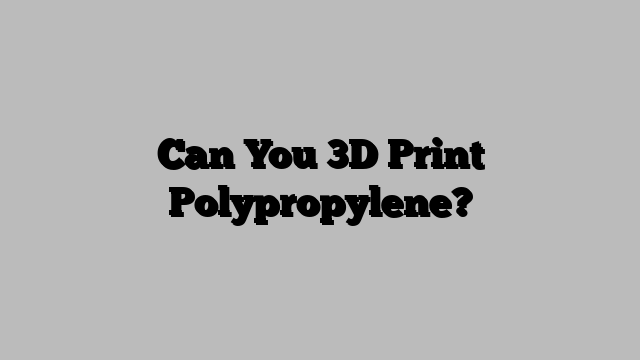Can You 3D Print Polypropylene?
Polypropylene is a popular thermoplastic material used in various industries such as automotive, packaging, and consumer products. It is known for its durability, resistance to chemicals, and flexibility. Due to its properties, many people are curious if it is possible to 3D print with polypropylene. In this article, we will explore whether or not it is possible to 3D print with polypropylene and what you need to know about the process.
The Short Answer: Yes, You Can 3D Print with Polypropylene
The good news is that it is possible to 3D print with polypropylene. However, it is not as simple as printing with other materials like PLA or ABS. Polypropylene has a high melting point and is very flexible, which makes it difficult to work with using traditional 3D printing methods.
Fused Deposition Modeling (FDM) 3D Printing
Fused Deposition Modeling (FDM) is the most common type of 3D printing technology used today. FDM 3D printers work by melting a plastic filament and extruding it through a nozzle to create a 3D object layer by layer. However, most FDM 3D printers are not designed to work with polypropylene due to its high melting point and flexibility.
To print with polypropylene on an FDM printer, you will need a special polypropylene filament that has been modified to work with the FDM printing process. These filaments are usually mixed with other materials to lower the melting point and increase the stiffness of the plastic. Additionally, you will need to modify your printer settings to account for the unique properties of polypropylene, such as its tendency to warp and shrink during the printing process.
Selective Laser Sintering (SLS) 3D Printing
Selective Laser Sintering (SLS) is another type of 3D printing technology that is more suited for printing with polypropylene. SLS printers work by using a high-powered laser to melt and fuse a powder material, such as polypropylene, into a 3D object. SLS printing is often used in industrial applications because it can produce complex parts with high accuracy and strength.
However, SLS printers are not as widely available or affordable as FDM printers, which may limit their accessibility to some users.
Conclusion
In summary, it is possible to 3D print with polypropylene, but it requires some modifications and adjustments to the printing process. FDM 3D printers can print with polypropylene using modified filaments and printer settings, while SLS printers are better suited for printing with polypropylene due to their ability to work with high-temperature and flexible materials. If you are interested in 3D printing with polypropylene, it is important to do your research and choose the right materials and equipment for your specific needs.
